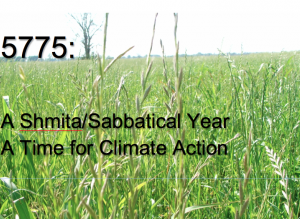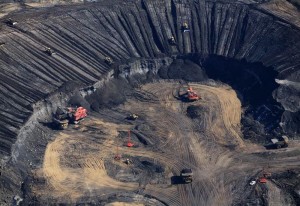How Is This Rosh Hashanah Different from All Other Rosh Hashanahs?
This Rosh Hashanah will be different from all other Rosh Hashanahs.
At the religious and spiritual level, 5775 will be a seventh year according to the ancient counting, a Sabbatical Year of Shmita (“release” or “non-attachment”). In such a year, Torah (Leviticus 25) commands that the earth be allowed to rest.
This will be the first Sabbatical/Shmita Year since the dispersion and exile of Jews from the land of Israel about 2,000 years ago in which there is serious consideration of how to carry out the shmita. It’s a very different world from that in which shmita began — among shepherds and farmers, the indigenous peoplehood, of ancient Israel.
At the political and activist level, we are entering Rosh Hashanah with a major leap in involvement of the American Jewish community in addressing the climate crisis that is bringing global scorching upon the world — unprecedented droughts, floods, famines, with worse to come. More than 70 Jewish organizations have signed on as endorsers of the People’s Climate March in New York City on September 21, just a few days before Rosh Hashanah. This wave of involvement crested with the endorsement of the march by the Jewish Council on Public Affairs, the broadest umbrella group in American Jewish life, and by the Union for Reform Judaism, the body with the largest number of individual members.
The effort to engage American Jews in the March was initiated by The Shalom Center and Hazon — the former (full disclosure) the organization I lead; the latter, through its Jewish Greening Fellowship led by Mirele Goldsmith. At the Climate March, dozens of Jews — perhaps even 100 — will lead the Jewish contingent by blowing the shofar in its ancient message, rooted in the shepherds’ relationship with the Earth: Sleepers Awake!
The massive involvement of shofar-blowers in this way betokens the entire process of engaging the Jewish community with ancient ideas in a new world. For centuries, there has been a tradition that on every morning of the month of Elul, the month just before Rosh Hashanah, individuals blow one long shofar blast in order to signal the coming of the New Year and the need to right old wrongs and renew compassion. Yet a mass blowing of the shofar to call for new political action to heal the earth is a new way of signaling Jewish activism rooted in the Spirit.
The path into activist eco-Judaism has not been an easy one. Back in 1982, when my book “Seasons of Our Joy: A Modern Guide to the Jewish Holidays” was published, the first review of the book in a Jewish magazine denigrated it as “pagan” because it described the roots of each of the festivals and fasts in the cycles of nature — the dance of sun, moon, and earth.
One generation later, the Jewish community kvells in this earthy understanding of the festival cycle. And during the last 10 years, there have grown up several dozen eco-Jewish organizations — beginning with Jewishly committed organic farms in the countryside and in cities; continuing with the growth of Hazon with its signature pro-Earth bike ride and its commitment to the revitalization of food justice as a Jewish value; all leading to the creation of the Green Hevra as a loose network of eco-Jewish organizations.
But it has been harder to mobilize activist Jewish advocacy on the climate question. There has been one main counterforce in the Jewish world: the focus of some organizations, especially the American Jewish Committee, on the notion of “energy independence,” or “energy security” This has meant supporting the exploration and exploitation of all energy sources that do not come from the Arab world — including Tar Sands in Canada and the XL pipeline intended to bring tar sands oil to Texas; mountain destruction for the sake of coal in West Virginia; penetration of the Gulf of Mexico and the Atlantic Coast by oil drilling; the fracking of large areas of Pennsylvania and North Dakota for the sake of new supplies of oil and gas.
All this is presumably being done as a way of insulating American foreign policy from pressures of the Arab world against Israel. But all of it ignores that the most existential threat to Israel is the scorching of our planet. Israeli scientists have warned that if the present emission rates continue unchecked, the Negev desert is likely to move more than 100 miles north, and Tel Aviv will find itself underwater. What would be left of the State of Israel as we know it? Yet AIPAC isn’t lobbying Congress for a strong carbon tax.
Indeed, a more thoughtful approach to protecting Israel — as well as to healing California from its unprecedented drought, New York from its unprecedented flooding, the Gulf Coast from the worsening of hurricanes because the waters are hotter and the coastal wetlands that used to protect New Orleans have been shattered by oil wells — would be the engagement of the American Jewish community in vigorous action to radically reduce emissions of carbon dioxide and methane in America and throughout the planet.
That would, of course, require a massive shift to renewable forms of energy — especially solar and wind sources. Beginning in 1940, it took the increasing danger of world war to make it possible and necessary for the American economy to utterly transform itself into a war economy. Today it would take a similar realization that we face an extraordinary emergency to shift the American economy from carbon to renewable energy. The American Jewish community ought to be a leading voice in such an effort.
Mobilizing American Jews for vigorous advocacy on climate policy has also stumbled over the conventional Jewish commitment to social justice — because it has been hard for many social-justice organizations to understand that the climate crisis is probably the worst threat to the poor in America, as well as in Africa, Asia, and Latin America. We are just beginning to think in terms of “eco-social justice.”
As we enter the Sabbatical/Shmita Year, the most important question will be whether support for the People’s Climate March will sow vigorous climate activism at the national, regional, and local levels.
Will the Jewish community support a strong national tax on carbon? Will Jewish communities in key cities like Baltimore, Miami, Chicago, and Los Angeles campaign for a multidimensional local and regional shift away from carbon and into wind and solar energy? Into multiplying bikes and public transportation while minimizing automobiles? Into revising building codes in favor of minimal carbon burning?
The Shalom Center has put forward a plan to Move Our Money, Protect Our Planet. That would mean shifting purchases at the household and congregational level from, for example, buying electric power from coal burning to buying electric power from wind energy. It would mean moving our money from banks that invest in carbon corporations to community banks and credit unions. It would mean checking out our credit cards to see whether the banks that issue them are investing in carbon corporations or not. It would mean moving synagogue endowment funds and the pension funds of our major denominations from funding lethal Carbon Pharaohs to investing in life-giving enterprises.
Leviticus 25 calls for us to let the earth rest. Leviticus 26 asks what happens if we refuse to let the earth rest. And it answers that the earth will rest anyway — on our heads, through famine, flood, drought, exile. Now it is the whole round sacred globe, not only a sacred sliver of land on the eastern coast of the Mediterranean, that faces famine, flood, drought — millions or billions of refugees in restless and disruptive exile.
Can we Jews bring our own ancient wisdom and our own modern political clout and smarts into the service of God’s earth, beginning in this coming Sabbatical/Shmita Year?
Editor’s Note: This article is part of a special ZEEK series on climate justice. ZEEK Magazine is a proud partner of the People’s Climate March and the Jewish Climate Change Campaign, one of more than 80 participating Jewish orgs. Please join us — and our friends and families — in NYC on September 21st! Why? American Jews care about climate justice. Visit our Facebook page for more information!
Essential Reading & Resources:
On Despair and Hope: A Jewish Call for Climate Action by Hila Ratzabi in ZEEK
The People’s Climate March NYC by Hazon’s Mirele Goldsmith
The People’s Climate March, official site
![[the current issue of ZEEK]](../../image/2/100/0/5/uploads/leftistethicistgraphic-52842c6a.png)
- 5000 Pages of Zeek
- Founded in 2001, Zeek was the first Jewish online magazine, and we have over 5000 pages online to prove it, all available free of charge. Read more in the Archive.
More articles by
Rabbi Arthur Waskow
More articles in
Faith and Practice
- To-Do List for the Social Justice Movement: Cultivate Compassion, Emphasize Connections & Mourn Losses (Don’t Just Celebrate Triumphs)
- Inside the Looking Glass: Writing My Way Through Two Very Different Jewish Journeys
- What Is Mine? Finding Humbleness, Not Entitlement, in Shmita
- Engaging With the Days of Awe: A Personal Writing Ritual in Five Questions
- The Internet Confessional Goes to the Goats



